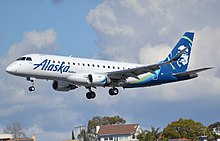China Airlines is the state-owned flag carrier of the Republic of China (Taiwan). It is one of Taiwan's two major airlines along with EVA Air. It is headquartered in Taoyuan International Airport and operates over 1,400 flights weekly – including 91 pure cargo flights – to 102 cities across Asia, Europe, North America, and Oceania. Carrying nearly 20 million passengers and 5700 tons of cargo in 2017, the carrier was the 33rd largest airline in the world in terms of revenue passenger kilometers (RPK) and 10th largest in terms of freight revenue ton kilometers (FRTK).

The Boeing 737 is an American narrow-body airliner produced by Boeing at its Renton factory in Washington. Developed to supplement the Boeing 727 on short and thin routes, the twinjet retained the 707 fuselage width and six abreast seating but with two underwing Pratt & Whitney JT8D low-bypass turbofan engines. Envisioned in 1964, the initial 737-100 made its first flight in April 1967 and entered service in February 1968 with Lufthansa. The lengthened 737-200 entered service in April 1968, and evolved through four generations, offering several variants for 85 to 215 passengers.

The Boeing 757 is an American narrow-body airliner designed and built by Boeing Commercial Airplanes. The then-named 7N7, a twinjet successor for the trijet 727, received its first orders in August 1978. The prototype completed its maiden flight on February 19, 1982, and it was FAA certified on December 21, 1982. Eastern Air Lines placed the initial 757-200 variant in commercial service on January 1, 1983. A package freighter (PF) variant entered service in September 1987 and a combi model in September 1988. The stretched 757-300 was launched in September 1996 and began service in March 1999. After 1,050 had been built for 54 customers, production ended in October 2004, while Boeing offered the largest 737 NG variants as a successor to the -200.
Icelandair is the flag carrier of Iceland, with its corporate head office on the property of Reykjavík Airport in the capital city Reykjavík. It is part of the Icelandair Group and operates to destinations on both sides of the Atlantic Ocean from its main hub at Keflavík International Airport. The geographical position of Iceland is convenient for one-stop transatlantic flights via the Atlantic Bridge route, which is one pillar of the airline's business strategy, along with traffic to, from, and within the country.
All Nippon Airways Co., Ltd. is a Japanese airline headquartered in Minato, Tokyo. ANA operates services to both domestic and international destinations and is Japan's largest airline, ahead of its main rival flag carrier Japan Airlines. As of April 2023, the airline has approximately 12,800 employees. The airline joined as a Star Alliance member in October 1999.
Alaska Airlines is a major American airline headquartered in SeaTac, Washington, within the Seattle metropolitan area. It is the fifth-largest airline in North America when measured by scheduled passengers carried. Alaska, together with its regional partners Horizon Air and SkyWest Airlines operates a route network primarily focused on connecting cities along the West Coast of the United States to over 100 destinations in the contiguous United States, Bahamas, Belize, Canada, Costa Rica, Guatemala and Mexico.

Air North Charter and Training Ltd., operating as Air North, Yukon's Airline, is a Canadian airline based in Whitehorse, Yukon. It operates scheduled passenger and cargo flights throughout Yukon, as well as between Yukon and the Northwest Territories, British Columbia, Alberta, and Ontario. The airline also operates charter flights throughout Canada and Alaska. The airline also provides ground handling services and fuel services to other airlines throughout Yukon, and it also provides ground handling services at Vancouver International Airport and Edmonton International Airport. Its main base is Erik Nielsen Whitehorse International Airport.
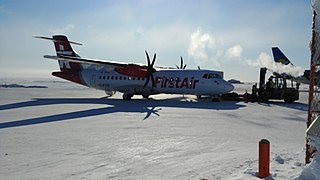
Bradley Air Services Limited, operating as First Air, was an airline headquartered in Kanata, a suburb of Ottawa, Ontario, Canada. It operated services to 34 communities in Nunavut, Nunavik, and the Northwest Territories. First Air has assisted in various humanitarian missions such as the 2010 Haiti earthquake, airlifting relief supplies and equipment. Its main base, which included a large hangar, cargo and maintenance facility, was located at Ottawa Macdonald–Cartier International Airport, with hubs at Iqaluit Airport, and Yellowknife Airport. On November 1, 2019, the airline consolidated operations with Canadian North.

Air Namibia (Pty) Limited, which traded as Air Namibia, was the national airline of Namibia, headquartered in the country's capital, Windhoek. It operated scheduled domestic, regional, and international passenger and cargo services, having its international hub in Windhoek Hosea Kutako International Airport and a domestic hub at the smaller Windhoek Eros Airport. As of December 2013, the carrier was wholly owned by the Namibian government. Air Namibia was a member of both the International Air Transport Association and the African Airlines Association.
Pacific Western Airlines Ltd (PWA) was an airline that operated scheduled flights throughout western Canada and charter services around the world from the 1950s through the 1980s.

Les Investissements Nolinor Inc., trading as Nolinor Aviation, is a charter airline based in Mirabel, a suburb of Montreal, Quebec, Canada. It operates passenger charter and cargo services within Canada and to the United States Its main base is Montréal–Mirabel International Airport. It has 200 employees.

Combi aircraft in commercial aviation are aircraft that can be used to carry either passengers as an airliner, or cargo as a freighter, and may have a partition in the aircraft cabin to allow both uses at the same time in a mixed passenger/freight combination. The name combi comes from the word combination. The concept originated in railroading with the combine car, a passenger car that contains a separate compartment for mail or baggage.

Juneau International Airport is a city-owned, public-use airport and seaplane base located seven nautical miles northwest of the central business district of Juneau, a city and borough in the U.S. state of Alaska which has no direct road access to the outside world. The airport is a regional hub for all air travel, from bush carriers to major U.S. air carriers such as Alaska Airlines.
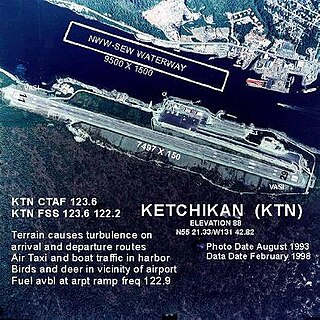
Ketchikan International Airport is a state-owned, public-use airport located one nautical mile (2 km) west of the central business district of Ketchikan, a city in Ketchikan Gateway Borough in Alaska, that has no direct road access to the outside world or to the airport. The airport is located on Gravina Island, just west of Ketchikan on the other side of the Tongass Narrows. Passengers must take a seven-minute ferry ride across the water to get to the airport from the town.
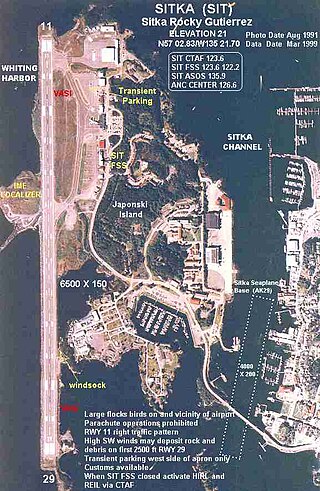
Sitka Rocky Gutierrez Airport is a state-owned, public-use airport located west of the central business district of Sitka, a city and borough in the U.S. state of Alaska.
UPS Airlines is a major American cargo airline based in Louisville, Kentucky. One of the largest cargo airlines worldwide, UPS Airlines flies to 815 destinations worldwide. It has been a wholly owned subsidiary of United Parcel Service since its launch in 1988.

As of June 2024, the American Airlines fleet consists of 968 mainline aircraft, making it the second-largest commercial airline fleet in the world. American Airlines operates aircraft manufactured by Boeing and Airbus.
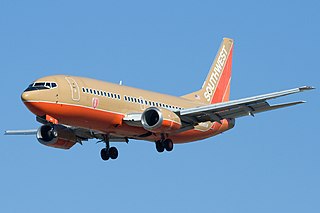
The Boeing 737 Classic is a series of narrow-body airliners produced by Boeing Commercial Airplanes, the second generation of the Boeing 737 series of aircraft. Development began in 1979 and the first variant, the 737-300, first flew in February 1984 and entered service that December. The stretched 737-400 first flew in February 1988 and entered service later that year. The shortest variant, the 737-500, first flew in June 1989 and entered service in 1990.

As of May 2024, the Southwest Airlines fleet consists of 817 aircraft, making it the fourth-largest commercial airline fleet in the world. All of the aircraft Southwest Airlines operates are from the Boeing 737 family of narrow-body airliners.

As of December 2023, the Air Canada fleet consists of 187 mainline passenger aircraft, a mix of Airbus and Boeing narrow-body and wide-body jets.

